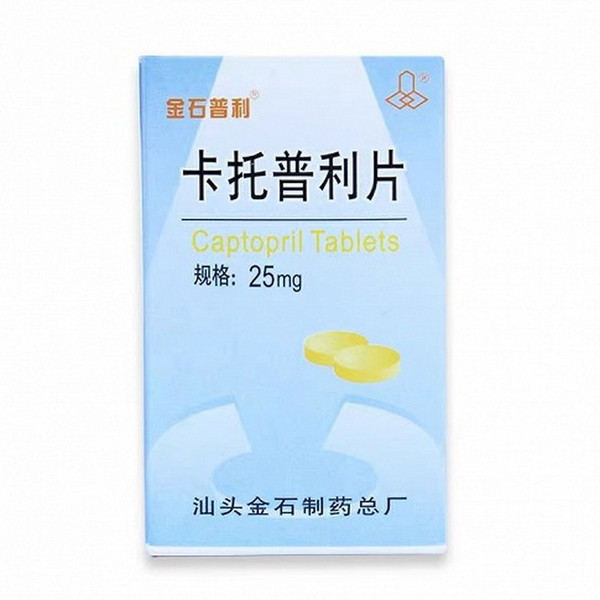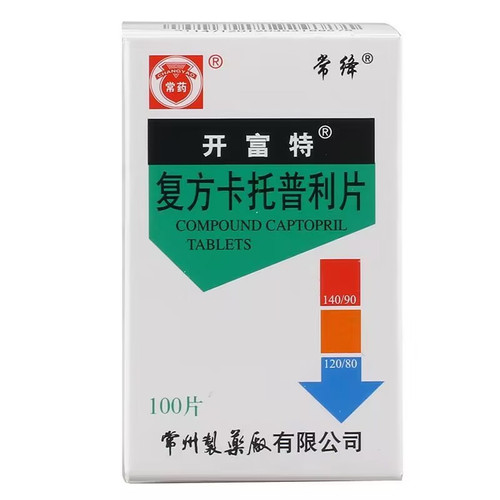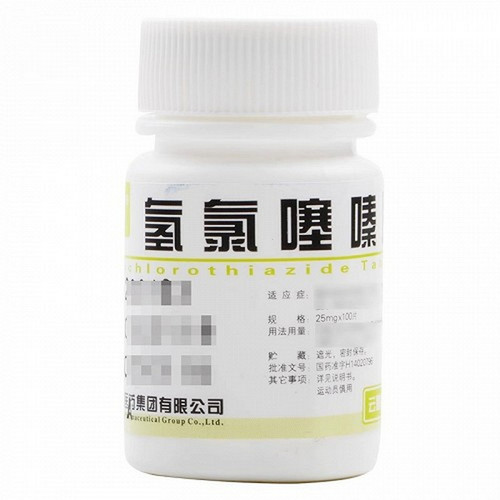Product Overview
[Drug Name]
Generic Name: Captopril Tablets
Trade Name: Jinshi Puli
English Name: Captopril Tablets
Chinese Pinyin: Katuopuli Pian
[Ingredients]
The main ingredient of this product is captopril, whose chemical name is: l-[(2S)-2-methyl-3-mercapto-l-oxopropyl]-L-proline
[Properties]
This product is white or off-white tablets.
[Indications]
1. Hypertension; 2. Heart failure.
[Usage and Dosage]
Depends on the condition or individual differences. This product should be taken under the guidance or supervision of a physician. The dosage must follow the principle of individualization and be adjusted according to the efficacy.
1. Common dosage for adults:
(1) For hypertension, take 12.5 mg (half a tablet) orally once, 2-3 times a day. Increase to 50 mg (2 tablets) within 1-2 weeks as needed, 2-3 times a day. If the efficacy is still unsatisfactory, other antihypertensive drugs can be added.
(2) Heart failure: Start with a single oral dose of 12.5 mg (half a tablet), 2-3 times a day. If necessary, gradually increase to 50 mg (2 tablets), 2-3 times a day. If further dosage increase is needed, it is advisable to observe the efficacy for 2 weeks before considering it: For patients who have recently taken a large amount of diuretics and are in hyponatremia/hypovolemia, but have normal or low blood pressure, the initial dose should be 6.25 mg (1/4 tablet), 3 times a day. Later, gradually increase to the usual dose through testing.
2. Common dosage for children: For both antihypertensive and heart failure treatment, start with 0.3 mg/kg of body weight, 3 times a day. If necessary, increase by 0.3 mg/kg every 8-24 hours to obtain the lowest effective dose.
[Adverse Reactions]
1. The more common ones are: (1) Rash, which may be accompanied by itching and fever, and often occurs within 4 weeks of treatment. It appears as maculopapular rash or urticaria, and disappears after reducing the dose, stopping the drug, or giving antihistamines. 7% to 10% are accompanied by eosinophilia or positive antinuclear antibodies. (2) Palpitations, tachycardia, chest pain. (3) Cough. (4) Taste loss. 2. Less common are: (1) Proteinuria, which often occurs within 8 months after the start of treatment. 1/4 of them develop nephrotic syndrome, but proteinuria gradually decreases within 6 months and the course of treatment is not affected. (2) Dizziness, headache, and syncope. Caused by hypotension, especially when there is sodium deficiency or hypovolemia. (3) Angioedema, which occurs on the face and limbs and can also cause angioedema of the tongue, glottis, or larynx. Be vigilant. (4) Rapid and irregular heart rate. (5) Facial flushing or pallor. 3. Rare are: Leukopenia and granulocytopenia, with fever and chills. Leukopenia is dose-related and occurs 3-12 weeks after the start of treatment, with the most significant symptoms being 10-30 days. It lasts for 2 weeks after discontinuation of the drug. Patients with renal failure should be more vigilant. Taking allopurinol together may increase this risk.
[Contraindications]
This product is contraindicated in patients who are allergic to this product or other angiotensin-converting enzyme inhibitors.
[Precautions]
1. Food in the stomach can reduce the absorption of this product by 30-40%, so it is advisable to take the drug 1 hour before meals. 2. Interference with diagnosis: This product can increase the concentration of blood urea and creatinine, which is often temporary. It is easy to occur after a rapid drop in blood pressure in patients with kidney disease or long-term severe hypertension. Occasionally, serum liver enzymes may increase: This may increase blood potassium. When used in combination with potassium-sparing diuretics, blood potassium should be checked. 3. This product should be used with caution in the following situations: (1) Autoimmune diseases such as severe systemic lupus erythematosus, in which case the chance of leukopenia or granulocytopenia increases. (2) Bone marrow suppression. (3) Insufficient blood supply to the cerebral artery or coronary artery. Ischemia may be aggravated by lowered blood pressure. (4) Hyperkalemia. (5) Renal dysfunction leading to increased blood potassium, decreased white blood cells and granulocytes, and retention of this product. (6) Aortic valve stenosis, which may reduce coronary artery perfusion. (7) Patients with strict dietary sodium restriction or dialysis. In this case, the first dose of this product may cause sudden and severe hypotension. 4. Follow-up examination during the use of this product: (1) White blood cell count and differential count, once every 2 weeks for the first 3 months. Thereafter, regular examinations should be conducted, and examinations should be conducted immediately if there are signs of infection. (2) Urine protein test once a month. 5. Patients with poor renal function should use a small dose or reduce the number of doses and increase the dose slowly; if diuretics must be used at the same time, furosemide is recommended instead of thiazides. When blood urea nitrogen and creatinine increase, reduce the dose of this product or stop the diuretic at the same time. 6. If proteinuria gradually increases while using this product, suspend this product or reduce the dosage. 7. If the white blood cell count is too low while using this product, suspend this product. It can be recovered. 8. If vasoconstriction occurs while using this product, discontinue use and promptly administer 0.3-0.5 ml of 1:1000 epinephrine subcutaneously. 9. This product may cause a false-positive urine acetone test result.
[Use in Pregnant and Breastfeeding Women]
1. This product can cross the placenta and may harm the fetus. If pregnancy is detected, discontinue use immediately. 2. This product can be excreted into breast milk, where its concentration is approximately 1% of the maternal blood concentration. Therefore, nursing women should carefully weigh the risks and benefits before using this product.
[Use in Children]
This product has been reported to cause an excessive and prolonged decrease in blood pressure, accompanied by oliguria and seizures, in infants. Therefore, its use is limited to patients who have not responded to other antihypertensive treatments.
[Use in Elderly Patients]
The elderly are more sensitive to antihypertensive effects; therefore, the dose of this product should be reduced.
[Use in Special Populations]
Precautions for Children: This product has been reported to cause an excessive and prolonged decrease in blood pressure, accompanied by oliguria and seizures, in infants. Therefore, its use is limited to patients who have not responded to other antihypertensive treatments. Precautions During Pregnancy and Lactation: 1. This product crosses the placenta. 2. This product is excreted in breast milk at a concentration approximately 1% of the maternal blood concentration. Therefore, the risks and benefits of using this product must be carefully considered before using it in lactating women. 3. Absorption of ACEI by pregnant women can affect fetal development and even cause fetal death. Therefore, this product is contraindicated in pregnant women.
Precautions for the Elderly: Elderly individuals are more sensitive to antihypertensive effects; therefore, the dose of this product should be reduced as appropriate.
[Drug Interactions]
1. Concomitant use with diuretics enhances the antihypertensive effect. However, severe hypotension should be avoided. Therefore, patients currently taking diuretics should discontinue or reduce their dose. Initially use this product at a low dose and gradually adjust the dose. 2. Concomitant use with other vasodilators may cause hypotension. If combined, start with a low dose. 3. Concomitant use with potassium-retaining drugs such as spironolactone, triamterene, and amiloride may cause hyperkalemia. 4. Concomitant use with endogenous prostaglandin synthesis inhibitors such as indomethacin may weaken the antihypertensive effect of this product. 5. Concomitant use with other antihypertensive drugs may enhance the antihypertensive effect. Concomitant use with drugs that affect sympathetic nervous system activity (ganglionic or adrenergic blockers) and beta-blockers may result in an enhanced antihypertensive effect and should be used with caution. Combination with lithium may increase serum lithium levels and lead to toxicity.
[Pharmacological Actions: Overdose]
Overdose may cause hypotension, which should be corrected by immediate discontinuation of the drug and volume expansion. Hemodialysis can also be used for removal in adults.
[Storage] Store in a dark, sealed container.
[Strength] 25 mg
[Packaging] Plastic bottle, 100 tablets per bottle.
[Expiry Date] 24 months.
[Approval Number] National Medicine Standard H44024904
[Manufacturer] Company Name: Sinopharm Group Shantou Jinshi Pharmaceutical Co., Ltd.






